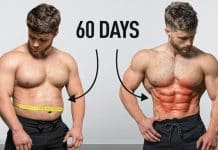 by Stuart McRobert
by Stuart McRobert
Is your training working, and building muscle?
If it isn’t, it’s time to find out why, and then make changes.
Start by understanding the BIG LIES of bodybuilding.
The BIG LIES are described in the context of drug-free, genetically normal bodybuilders, who are the target audience for this four-part series of articles.
But some of the BIG LIES are truths in the context of bodybuilders who are drug-assisted or genetically highly gifted. Especially so for bodybuilders who are drug-assisted AND genetically highly gifted.
.
BIG LIE #1: Routines that work for the biggest bodybuilders also work for other bodybuilders
The high-volume routines that work well for the biggest bodybuilders only work well for people who have the same genetic advantages and drug support that the biggest guys have.
While the hugely muscled men know what works well for them, that doesn’t mean they know what works for drug-free bodybuilders with normal genetics for bodybuilding.
Someone who struggled for years without building any muscle, but then managed to build 20 pounds of muscle drug-free, knows way more about how to train genetically normal, drug-free bodybuilders than does a genetic phenomenon on drugs who has built over 100 pounds of muscle.
.
BIG LIE #2: Train more often to grow more muscle
Of course, you must have sufficient training frequency (and volume) in order to build muscle, but that “sufficient” is a lot less than what most bodybuilders think is required.
There may seem to be some logic to BIG LIE #2 because, in many activities, the more often that a skill is practiced properly, the quicker that competence is acquired.
But bodybuilding training isn’t like pure skill training.
Furthermore, when someone discovers that a modest frequency of proper training builds muscle, there’s a tendency to think that training more often will yield even better results.
A bodybuilding workout will build muscle only if it safely stimulates growth AND is followed by sufficient recovery time AND supply of nutrients to permit the body to heal, which means to recover from the training and build a very small amount of overcompensation tissue — muscle.
Train too often, and you may not stimulate any growth because you’re unable to train hard enough due to the excessive frequency of training. And even if you do stimulate growth, you’ll not have sufficient recuperation time between workouts to permit the growth to occur.
It’s very easy for a drug-free bodybuilder with normal genetics to overtrain. But someone with outstanding genetics for bodybuilding can prosper on more frequent training, and such a person can prosper on even more frequent training if he’s on bodybuilding drugs.
Hardgainers are best off training no more than three times a week, but with just twice a week being ideal for most of them. But the super-responsive, drug-assisted bodybuilding elite can prosper on six workouts a week. (Some, for short periods, have progressed on twice-daily training, six days a week.)
Such high frequency is training suicide for hardgainers. But even the pros can overtrain. Many of them have discovered that, even with their huge advantages, when they cut back on their training frequency (and volume) they are better able to build muscle.
Don’t think that by splitting your training over, say, four workouts a week is necessarily easier on your recovery system than two brief full-body workouts.
Because the muscular system is so interwoven, and many exercises overlap in the muscles they recruit, some of the same muscles get worked at every workout on some split routines.
Furthermore, intensive training even for just a limited area of musculature still has an overall systemic demand that needs to be recovered from before you work another area of your physique.
Sufficient recovery time — which means lots of it for hardgaining bodybuilders — is essential in order to build muscle.
.
BIG LIE #3: Train longer to build more muscle
The origins of this lie are the same as for the previous one.
Men and women with exceptional genetic talent for an athletic activity, especially when assisted by performance enhancing drugs, can prosper on a far greater volume of training than can drug-free, genetically normal athletes.
Some great medium- and long-distance runners, for example, inherited an ability to process oxygen and produce energy that’s in another world relative to that of a normal person. Of course, the great runners further enhance their natural advantages with great dedication to training, but they had way more to work with from day one. The same sort of point applies in the bodybuilding world.
As little as just one work set can stimulate muscle growth, provided that its quality is high enough. If you ever need to do more than three work sets for a given exercise, you must be loafing. Train harder.
Make three work sets per exercise your ceiling. Sometimes, just one or two work sets per exercise is better.
Some body parts are much larger than others, and can sometimes benefit from multiple exercises in a given program, but there’s no need to do a great many sets per body part.
Too much training is as counterproductive as training too often. But most hardgaining bodybuilders train too often AND do too many sets per workout, and that combination is a major part of the explanation for why they continue to make little or no progress.
Head on to page 2 for more BIG lies!















